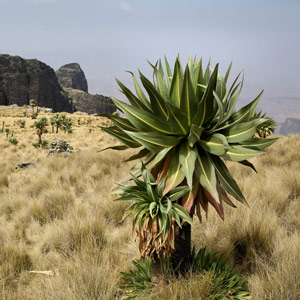Magazine | Voyages
Observer les oiseaux sur les hauts plateaux éthiopiens

Lobélie géante (Lobelia giberroa), montagnes du Simien (Éthiopie).Photographie : Bruno Tredez
Introduction
Les hauts plateaux éthiopiens, qui s’élèvent au-dessus de 1 500 mètres d’altitude, forment la plus vaste zone montagneuse d’Afrique. Ils culminent à 4 620 mètres d’altitude au Ras Dejen, le plus haut sommet d’Éthiopie. Ils sont séparés en deux par le Grand Rift.
Etant situés près de l’équateur, leur climat est relativement tempéré. En outre, ils reçoivent des précipitations entre juin et la mi-septembre (mousson). Différents écosystèmes se succèdent en fonction de l’altitude : des forêts tropicales de montagne, une mosaïque de prairies, de fourrés et de boisements, puis des landes alpines.
On peut y observer une proportion importante des oiseaux endémiques d’Éthiopie, comme le Corbeau corbivau, l’Ibis caronculé, l’Ouette à ailes bleues, le Vanneau d’Abyssinie ou le Râle de Rouget, mais aussi des mammifères uniques comme le Loup d’Éthiopie ou le Nyala des montagnes.
Après une présentation des principaux oiseaux endémiques de ces hauts plateaux, nous vous indiquons plusieurs sites ornithologiques remarquables, dont les parcs nationaux du Mont Balé et du Simien.
Bruno Tredez (voir son site web), qui a visité le secteur compris entre le parc national du Simien et la ville de Lalibela en janvier 2013, nous a transmis de nombreuses photos. Nous remercions aussi Tessa Veldhorst et Ingeborg van Leeuwen pour nous avoir aidés à compléter l’illustration.
Abstract
Ethiopia is one of best African country to watch birds : more than 800 species of birds, including staggering 29 endemics to Ethiopia and its neighbour Eritrea, have been recorded. Ethiopia has a also several endemic mammals like the Ethiopian wolf, and a fascinating diversity and cultural richness (numerous and old monasteries, churches, …). The highlands, which dominate the country, are bisected by the Rift Valley. Despite must of their original ecosystems have been cleared for agriculture, there are still tracts of afro-alpine habitats and montane forests. This huge mountainous area is the domain of very interesting endemic species such as the Spot-breasted Lapwing, the Rouget`s Rail, the Blue-winged Goose, the Wattled Ibis or the Abyssinian Longclaw.
In this article, we present you the main endemic bird species of the Ethiopian highlands, and several good birding areas. Bruno Tredez, who visited the area comprised between the Simien National Park and the city of Lalibela in January 2013, sent us some nice photos.
Poursuivez la lecture de cet article, en vous abonnant dès maintenant !
Découvrez les Archives d’Ornithomedia.com
Pour seulement 10,00 €TTC/an (ou 6,00 € les 6 mois)
Profitez de plusieurs centaines d’articles en accès illimité et sans aucun engagement.
Compléments
Auteur
Ornithomedia.com
À lire aussi sur Ornithomedia.com
Observer les oiseaux en Éthiopie
À lire sur le web
- Le site web de Bruno Tredez (avec notamment d’autres photos de son séjour en Ethiopie) : http://bruno.tredez.com/Voyages/Ethiopie13
- La galerie de Tessa Veldhorst : www.flickr.com/photos/tessa_v
- La galerie de Ingeborg van Leeuwen : www.flickr.com/photos/ivl_wildlife_photography/
- Les photos de Sabine Deschandol : http://sabine-deschandol.com
- Le rapport de Chris Lotz en mars-avril 2011 : www.surfbirds.com/trip_report.php?id=1976
- Le site web Selamta.net, riche en informations sur l’Ethiopie : www.selamta.net
- Le site web du Bale Mountains Conservation Park : http://balemountains.org
Ouvrages recommandés
- Birds of the Horn of Africa: Ethiopia, Eritrea, Djibouti, Somalia and Socotra de Terry Stevenson, John Fanshawe et Brian Small
- Birds of Eastern Africa de Ber van Perlo
- Birds of East Africa: Kenya, Tanzania, Uganda, Rwanda, Burundi de Terry Stevenson, John Fanshawe, Brian Small et John Gale
- Birds of Kenya and Northern Tanzania de Dale A. Zimmerman (Auteur), David J. Pearson (Auteur), Donald A. Turner
- Carte Ethiopia : 1/2000000 de ITMB
- Ethiopia & Eritrea de AA.VV.
- Guide des mammifères d’Afrique : Plus de 300 espèces illustrées de Jonathan Kingdon
- Birds of Africa South of the Sahara: A Comprehensive Illustrated Field Guide de Ian Sinclair, Peter Ryan





Aucun commentaire sur ce sujet
Participer à la discussion !